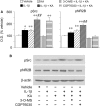A novel non-transcriptional pathway mediates the proconvulsive effects of interleukin-1beta
- PMID: 18952671
- PMCID: PMC2724908
- DOI: 10.1093/brain/awn271
A novel non-transcriptional pathway mediates the proconvulsive effects of interleukin-1beta
Abstract
Interleukin-1beta (IL-1beta) is overproduced in human and rodent epileptogenic tissue and it exacerbates seizures upon brain application in rodents. Moreover, pharmacological prevention of IL-1beta endogenous synthesis, or IL-1 receptor blockade, mediates powerful anticonvulsive actions indicating a significant role of this cytokine in ictogenesis. The molecular mechanisms of the proconvulsive actions of IL-1beta are not known. We show here that EEG seizures induced by intrahippocampal injection of kainic acid in C57BL6 adult mice were increased by 2-fold on average by pre-exposure to IL-1beta and this effect was blocked by 3-O-methylsphingomyelin (3-O-MS), a selective inhibitor of the ceramide-producing enzyme sphingomyelinase. C2-ceramide, a cell permeable analog of ceramide, mimicked IL-1beta action suggesting that ceramide may be the second messenger of the proconvulsive effect of IL-1beta. The seizure exacerbating effects of either IL-1beta or C2-ceramide were dependent on activation of the Src family of tyrosine kinases since they were prevented by CGP76030, an inhibitor of this enzyme family. The proconvulsive IL-1beta effect was associated with increased Tyr(418) phosphorylation of Src-family of kinases indicative of its activation, and Tyr(1472) phosphorylation of one of its substrate, the NR2B subunit of the N-methyl-d-aspartate receptor, which were prevented by 3-O-MS and CGP76030. Finally, the proconvulsive effect of IL-1beta was blocked by ifenprodil, a selective NR2B receptor antagonist. These results indicate that the proconvulsive actions of IL-1beta depend on the activation of a sphingomyelinase- and Src-family of kinases-dependent pathway in the hippocampus which leads to the phosphorylation of the NR2B subunit, thus highlighting a novel, non-transcriptional mechanism underlying seizure exacerbation in inflammatory conditions.
Figures



References
-
- Ali DW, Salter MW. NMDA receptor regulation by Src kinase signalling in excitatory synaptic transmission and plasticity. Curr Opin Neurobiol. 2001;11:336–42. - PubMed
-
- Aronica E, Boer K, van Vliet EA, Redeker S, Baayen JC, Spliet WG, et al. Complement activation in experimental and human temporal lobe epilepsy. Neurobiol Dis. 2007;26:497–511. - PubMed
-
- Balosso S, Ravizza T, Perego C, Peschon J, Campbell IL, De Simoni MG, et al. Tumor necrosis factor-alpha inhibits seizures in mice via p75 receptors. Ann Neurol. 2005;57:804–12. - PubMed
-
- Bock J, Szabo I, Gamper N, Adams C, Gulbins E. Ceramide inhibits the potassium channel Kv1.3 by the formation of membrane platforms. Biochem Biophys Res Commun. 2003;305:890–7. - PubMed
-
- Chenard BL, Menniti FS. Antagonists selective for NMDA receptors containing the NR2B subunit. Curr Pharm Des. 1999;5:381–404. - PubMed
Publication types
MeSH terms
Substances
Grants and funding
LinkOut - more resources
Full Text Sources
Other Literature Sources
Medical
Miscellaneous

